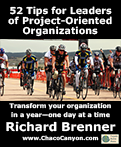As a leader Skip to the Details:
How To Orderof a project-oriented organization, you
face an unprecedented degree of uncertainty. Today's dynamic conditions and competitive
environment are conspiring to make executing even the most conservative project plan a thrill
ride, but that's only a small part of the problem — all managers face that one.
Your organization does its work as projects — unique or first-of-a-kind activities that your
organization  has never done before. And often, no organization has done them
before. Projects, as distinguished from operations, present special
problems. And managing organizations that tackle projects, as
opposed to operations, requires special approaches. That's why I wrote 52 Tips for Leaders of Project-Oriented Organizations. It's for people who don't
even have time to read the directions on their prescriptions.
has never done before. And often, no organization has done them
before. Projects, as distinguished from operations, present special
problems. And managing organizations that tackle projects, as
opposed to operations, requires special approaches. That's why I wrote 52 Tips for Leaders of Project-Oriented Organizations. It's for people who don't
even have time to read the directions on their prescriptions.
52 Tips for Leaders of Project-Oriented Organizations is a tips book that contains ideas that managers and leaders of project-oriented organizations can use right now to address the special problems of managing these organizations.
You'll get as much from this little tip book as you'll get from one of those two-pound books you don't have time to read. And once you start deploying some of the ideas you'll be reading about, you'll free up some time to think. Here are two samples:
Some sample tips
Here are some samples:
- Never confuse the accounting system with reality
- Accounting systems are fairly good at measuring concrete items, such as cash, revenue, outlays and so on. But many cost drivers in the project-oriented organization are difficult to measure, and they're often unrepresented in the accounting system.
- For instance, when we choose cubicles over walled offices, the cost savings are well represented in the Facilities budget. But the increased costs due to interruptions and depressed productivity of the cubicle occupants appear nowhere.
- When we rely on the accounting system to make decisions, we probably do well in the short term. But the long-term effects of the failure of the accounting system to model all costs often depress organizational performance.
- Make decisions based not on the projections of accounting-based systems, but on more realistic models of organization performance.
- Choose status-neutral site names
- When managing dispersed teams, we sometimes refer to the sites where team members work by names such as "HQ," "Corporate," "home office," "plant," "fab," "lab," "remote site" and "field office." These names can be toxic because they contain organizational status information.
- When site names denote organizational status or role, they affect the self-image of the people who work there. The effect can be so strong that it can actually influence career decisions. In team decision making, people who work at high-status sites can have undue influence.
- To help manage these effects, choose site names that are either arbitrary or geographical. For instance, name your sites after mountains or rivers, or national parks. Or refer to sites by local geographical features, such as a city or street.
- Status-neutral site names help members of dispersed teams see each other as peers, which leads to better decisions.
Table of contents
Here's a chapter-by-chapter summary of what you'll find in this book.
Click the folder icons to reveal (or hide) individual chapter content summaries, or:
- 1Never, ever, kill the messenger
- 2Subsidize your food service
- 3Geese don't land on twigs
- 4Tame the time card
- 5Make project restarts more common
- 6Have too many too-well-equipped conference rooms
- 7Look before you leap
- 8The cheapest way to run a project is with enough resources
- 9Know how to hear No
- 10Never confuse the accounting system with reality
- 11Walls are cheaper than hours
- 12Choose status-neutral site names
- 13In dispersed teams, distribute travel
- 14Understand the Hawthorne Effect
- 15Avoid Pygmalion side-effects
- 16Make space for serendipity
- 17Learn how to fight fire
- 18Don't rebuild the Chrysler Building
- 19Use custom software only where you can get an edge
- 20Size doesn't matter
- 21Know when to be at the leading edge
- 22Adding people slows things down
- 23Train too much
- 24Use bake-offs
- 25Find new ways to exploit information networks
- 26Recognize risk takers
- 27Master meeting madness
- 28WIIFM is toxic
- 29Educate everyone about trips to Abilene
- 30Learn from the lioness
- 31Know when to let someone else "sit in"
- 32Let the consultant do the diagnosis
- 33Start a project nursery
- 34Know the principles of quantum management
- 35Know when to declare Condition Red
- 36Understand scope creep
- 37Understand why complex projects are usually late
- 38Create a positive culture
- 39Don't just paint — decorate
- 40Put widely dispersed teams on Zulu time
- 41Know how to manage rumors
- 42Don't spam your own organization
- 43Commend commendors
- 44Support your travelers
- 45Manage your metaphors
- 46There are no full-time equivalents
- 47Take regular temperature readings
- 48Resistance to change isn't
- 49Risk management is a whole lot more than a risk list
- 50Provide coaching for non-executives
- 51Practice renewal
- 52Bonus Tip: Tell others about this booklet
What readers say
Here's a sample of reader's comments:
- You're stuff is brilliant! And — Thank you for sharing these ideas.
- You and Scott Adams both secretly work here, right?
- The articles are great, I enjoy getting them, and you always have something very interesting to say, or good points to raise.
- I really enjoy my weekly newsletters. I appreciate that the newsletter is a quick read and is much more intellectually stimulating than, say, reading a Dilbert cartoon.
- You fill a need that went unmet — a sort of Dr. Phil for Management!
- I have found your articles extremely accurate, inspiring and applicable to day-to-day. You have a great writing style and the lessons that you have shared with us are invaluable.
- More
Designed for busy people
Most of us have way too much to do to find much time to read. And the time we do have is broken up into small chunks. We need the knowledge, but too often, we don't have time to get it, and we can't wade through 15-page chapters that lay out lengthy discussions.
Knowledge products from Chaco Canyon Consulting are designed with busy people in mind. Here are some features that make reading our e-books fast and convenient.
- They're available on line
- It's fun to go to a bookstore, but you have to find the time to go to the store, find what you want, wait in line to pay for it, and get back from the store. For some of us, all that time is a challenge.
- With our knowledge products, you browse for your selection on line, and pay for it quickly and easily through ClickBank. You can do it anywhere that has an Internet connection.
- Instant downloads
- With some on-line stores, you have to wait for an email message with download instructions. The wait can be brief, but sometimes it's a day or so.
- With our knowledge products, receive download instructions instantly. After you select an item, you can have it in your possession in minutes.
- Universal data formats
- To use some on-line knowledge products, even those you download, you need a computer or mobile device, or worse—a computer with a specific operating system.
- Our knowledge products are available in near-universal formats—either hypertext (like this document you're reading right now), or Acrobat (PDF), or MP3. You can use them with any computer or device that supports the format of that product (either hypertext, PDF or MP3).
- Written for busy people
- Most business books are about 200-250 pages, with about 10 chapters. I don't know about you, but I don't have time to read a 225-page book cover-to-cover. There are lots of folks like us—that's why there's such a booming market in book condensations.
- Our ebooks cut out that middle step. They're designed to be read by people who don't have time for the typical business book. Our tip books consist of short paragraphs, two- to four sentences per tip. Each tip has a headline in bold. You can easily scan the book for tips that seem relevant to you and read only those. Read in any order, and read them in short sittings.
- We use hyperlinks
- Most books, even e-books, are meant to be read off-line. Because they stand alone, they contain material that you might not want to see.
- Our ebooks assume that you have the Internet nearby. If you want background material on a point we've made, just click. And some of our hyperlinks link to other places in the e-book itself, to help you tie things together is you read.
Details and how to order
After your purchase is approved, ClickBank presents a page that contains a link to a page where you can download your item immediately. You can load it onto your computer or mobile device, or print it. Your satisfaction is guaranteed by ClickBank's return policy.
Price: per copy.
Call for volume or site license pricing at the phone number below.
| Order 52 Tips for Leaders of Project-Oriented Organizations by credit card, for USD 7.77 each, using ClickBank.com. . |
